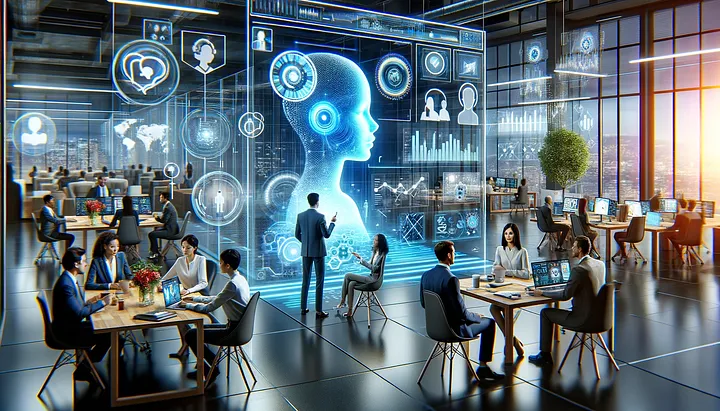How to Build a Culture of Continuous Learning: Preparing Your Team for the AI-Driven Future
Discover how leaders can foster continuous learning to equip their teams for an AI-driven world.
The rapid rise of AI technologies is reshaping industries and changing the way we work. To stay relevant in this ever-evolving landscape, continuous learning has become essential. Leaders who can foster a culture of learning and adaptability will position their teams for long-term success. But how do you create an environment where learning is encouraged, innovation thrives, and teams are ready to embrace the AI-driven future?
In this article, I’ll explore how leaders can build a culture of continuous learning that equips their teams with the skills they need to thrive in an AI-powered world. From embracing AI tools to designing learning programs that foster growth, we’ll look at practical strategies that empower teams to stay ahead of the curve.
1. Why Continuous Learning Is Essential in an AI-Driven World
The fast-paced evolution of AI technologies has made continuous learning more important than ever. In a world where automation and AI can quickly outpace existing skills, organisations that encourage a mindset of lifelong learning will be the ones that stay competitive. For leaders, the challenge is not just about keeping up with new technologies but also about preparing their teams to adapt to a landscape that is constantly changing.
AI is reshaping job roles, automating repetitive tasks, and creating new opportunities for innovation. However, this also means that employees need to continuously update their skills to stay relevant. Leaders who foster a culture of learning ensure that their teams remain resilient and capable of evolving alongside technological advancements.
How to Implement:
- Communicate the importance of continuous learning to your team, emphasising how it benefits both individual growth and organisational success.
- Create a forward-thinking environment where curiosity and learning are celebrated and encouraged.
Fostering a Learning Culture: Making Learning a Core Value
A culture of continuous learning begins with leadership. When learning is ingrained in the company’s values, it becomes a priority at every level. Leaders must model the behaviour they want to see—showing a willingness to learn, adapt, and grow in response to new challenges.
Building this culture also requires creating the right conditions for learning to thrive. This means offering employees the time, resources, and opportunities to pursue professional development. Leaders who encourage learning show their teams that investing in growth is not just acceptable—it’s essential.
How to Implement:
- Make learning a core value by integrating it into your company’s mission and everyday practices.
- Provide time and resources for employees to participate in learning and development initiatives.
- Recognise and reward continuous learning efforts within the team to reinforce its importance.
Embracing AI-Driven Tools for Learning and Development
AI itself can play a pivotal role in supporting continuous learning. AI-powered learning platforms can personalise training experiences, tailoring them to individual skill levels, learning preferences, and career goals. These tools can help leaders identify skill gaps, track progress, and deliver content that meets the specific needs of their team members.
Incorporating AI into learning and development not only makes the process more efficient but also empowers employees to take control of their own growth. AI-driven tools can provide real-time feedback, suggest learning paths, and even simulate real-world scenarios to help teams hone their skills.
How to Implement:
- Introduce AI-powered learning platforms that offer personalised learning experiences and track individual progress.
- Use AI tools to identify skill gaps within your team and develop targeted training programs to address them.
- Leverage AI simulations and case studies to provide hands-on learning opportunities for complex problem-solving.
Encouraging a Growth Mindset: Empowering Employees to Own Their Learning
At the heart of continuous learning is the concept of a growth mindset—the belief that skills and abilities can be developed through dedication and effort. Leaders play a crucial role in fostering this mindset by encouraging their teams to view challenges as opportunities for growth, rather than setbacks.
Empowering employees to take ownership of their learning journey is essential. When employees feel they have autonomy over their development, they are more likely to stay engaged and motivated. Leaders can support this by providing resources and opportunities for self-directed learning and encouraging exploration in areas that align with individual goals and interests.
How to Implement:
- Promote a growth mindset by encouraging experimentation, learning from mistakes, and continuous improvement.
- Empower employees to set their own learning goals and pursue areas of interest that align with both personal and organisational objectives.
- Offer flexibility in learning formats, from online courses to hands-on workshops, to accommodate diverse learning styles.
Creating a Feedback Loop: Measuring Learning Outcomes and Adapting
Continuous learning isn’t a one-size-fits-all approach. Leaders need to create a feedback loop that assesses the effectiveness of learning initiatives and adapts them over time. This involves regularly checking in with team members, gathering feedback, and measuring progress against learning objectives.
AI can assist in tracking learning outcomes, but the human element is just as important. Leaders should foster open communication, encouraging employees to share their learning experiences and challenges. This feedback can then be used to refine learning programs, ensuring they remain relevant and impactful as the organisation grows and evolves.
How to Implement:
- Regularly assess the effectiveness of learning initiatives by tracking progress and gathering employee feedback.
- Adjust learning programs based on real-time insights to ensure they continue to meet the needs of the team.
- Create a culture of open communication where employees feel comfortable sharing their learning experiences and providing feedback.
Key Points/Takeaways
- Continuous learning is essential for staying competitive in an AI-driven world, where adaptability and upskilling are critical to success.
- Fostering a learning culture begins with leadership, making learning a core value and providing resources to support it.
- AI-driven learning tools can personalise development experiences and identify skill gaps, making learning more efficient and effective.
- Empowering employees to own their learning fosters a growth mindset, keeping teams engaged and motivated to develop their skills.
- Creating a feedback loop ensures that learning initiatives remain relevant and are continually adapted to meet evolving needs.
Onward
Building a culture of continuous learning is not just about preparing your team for the future — it’s about ensuring that they can thrive in it. Leaders who embrace the power of learning, foster growth mindsets, and leverage AI tools will give their teams the edge they need to navigate an ever-changing landscape.






